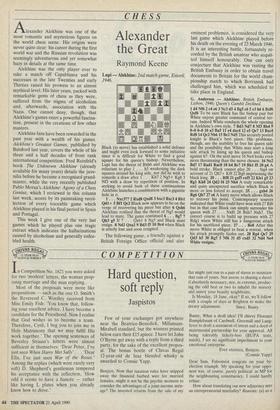CHESS
Alexander the Great
Raymond Keene
Alexander Alekhine was one of the most romantic and mysterious figures on the world chess scene. His origins were never quite clear: his career during the first world war and the Russian revolution was seemingly adventurous and yet somewhat hazy in details at the same time.
Alekhine was the only player ever to take a match off Capablanca and his successes in the late Twenties and early Thirties raised his prowess to an almost mythical level. His later years, packed with remarkable gems of chess as they were, suffered from the stigma of alcoholism and, afterwards, association with the Nazis. One cannot deny, though, that Alekhine's games exert a powerful fascina- tion, present in the creations of few other masters.
Alekhine fans have been rewarded in the past year with a wealth of his games. Alekhine's Greatest Games, published by Batsford last year, covers the whole of his three and a half decades of front rank international competition. Fred Reinfeld's book The Unknown Alekhine (already available for many years) details the juve- nilia before he became a recognised grand- master, while the very recently published Pablo Moran's Alekhine: Agony of a Chess Genius, which I reviewed in this column last week, scores by its painstaking recol- lection of every traceable game which Alekhine played in his final period in Spain and Portugal.
This week I give one of the very last games which he played plus one tragic extract which indicates the hallucinations caused by alcoholism and generally enfee- bled health. Lupi — Alekhine: 2nd match game, Estoril, 1946.
Black (to move) has established a solid defence and might even look forward to some initiative since it is difficult for White to find a good square for his queen's bishop. Nevertheless, Lupi has the threat of Bxh6 and Alekhine was reluctant to play 1 . . . 115 weakening the dark squares around his king side, nor did he wish to concede a draw after 1 . . . Kh7 2 Ng5+ Kg8 3 NO with a draw by repetition of position. In seeking to avoid both of these continuations Alekhine launches a combination with a gigantic hole in it.
1 . . . Nxc3?? 2 Rxd8 QxdS 3 bxc3 Bxc3 4 Rbl Qdl+ 5 Bfl Qc2 Black now appears to be on the verge of recovering his piece but after 6 Qxh6 Alekhine realised that the threat of Ng5 would lead to mate. The game continued 6 . . . Bg7 7 Qh3 g5 If 7 . . . Qxbl 8 Ng5 and Black must resign. 8 Nd2 Qxa2 9 Bd3 f5 10 Bc4 when Black is utterly lost and soon resigned.
The following game, a friendly against a British Foreign Office official and also eminent problemist, is considered the very last game which Alekhine played before his death on the evening of 23 March 1946. It is an interesting battle, fortunately re- corded by the British amateur who acquit- ted himself honourably. One can only conjecture that Alekhine was visiting the British Embassy in order to obtain travel documents to Britain for the world cham- pionship match to which Botvinnik had challenged him, which was scheduled to take place in England.
G. Anderson — Alekhine: British Embassy, Lisbon, 1946; Queen's Gambit Declined.
1 d4 Nf6 2 c4 e6 3 Nc3 d5 4 Bg5 c6 5 e3 h6 6 Bxf6 Qxf6 To be sure Black has the bishop pair but White enjoys greater command of central ter- rain. Indeed White conducts the whole opening in Alekhine's own style. 7 Bd3 Nd7 8 NO Bb4 9 0-0 0-0 10 a3 Ba5 11 e4 dxc4 12 e5 Qe7 13 Bxc4 Rd8 14 Qc2 Nb6 15 Bet Nd5 This securely posted knight is Black's best piece. His problems, though, are the inability to free his queen side and the possibility that White may start a king side attack by lining up his queen and bishop against h7. On the next move 16 Ne4 looks even more threatening than the move chosen. 16 Ne2 Bd7 17 Radl RacS 18 b4 Bc7 19 Bbl f5 20 g4 A bold stroke. Black cannot play 20 . . fxg4 on account of 21 0h7+ Kf8 22 Bg6 imprisoning the black king. 20 . . . Rf8 21 gxf5 exf5 22 Khl g5 23 Rgl Kh8 24 Qd2 f4 25 Nh4 A truly remarkable and quite unexpected sacrifice which Black is more or less forced to accept. 25 . . . gxh4 26 Rg6 Qh7 27 e6 A hasty move which allows Black to recover his poise. Contemporary sources indicated that White could have won with 27 Rf6 but in that case Black can simply surrender his queen with 27 . . . Nxf6 28 Bxh7 Nxh7. The correct course is to build up pressure with 27 Rdgl when White still has a dangerous attack for his sacrificed piece. 27 . . . Beil After this move White is obliged to beat a retreat, when his attack promptly fizzles out. 28 Rg4 Qe7 29 Qd3 h5 30 Rg5 5 Nf6 31 d5 cxd5 32 Nd4 Ne4 White resigns.


















































 Previous page
Previous page